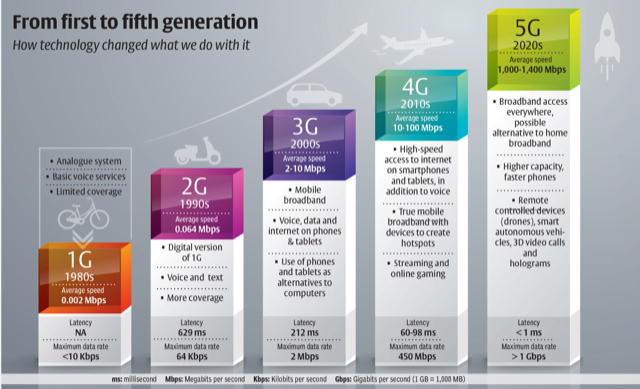UPSC Articles
INTERNATIONAL/ ECONOMY/ GOVERNANCE
Topic:
- GS-3: Science and Technology- developments and their applications and effects in everyday life
- GS-2: Government policies and interventions for development in various sectors and issues arising out of their design and implementation.
5G Trials in India
Context: The Department of Telecommunications allowed private telcos Airtel, Reliance Jio and Vi and well as state-run telco MTNL to start trials for 5G technology as well as its applications in various sectors. The trials will last for 6 months for now.
What is 5G?
- 5G is the fifth generation cellular technology that apart from increasing the downloading and uploading speeds (speed of 1 Gbps) over the mobile network, also reduces the latency i.e. the time taken by a network to respond.
- It also increases energy efficiency and offers more stable network connections.
- 5G is also designed to deliver signals more reliably than earlier cellular networks
- 5G will have a wider area in the frequency spectrum (range of frequencies) that will ensure no network congestion.
- In addition, it will also ensure connectivity to a full circle i.e. everything is connected to every other thing.
- 5G will help facilitate the ecosystem for the Internet of Things (IoT) and to incorporate Artificial Intelligence (AI) in our daily lives and
- To get the benefits of 5G, users will have to buy new phones, while carriers will need to install new transmission equipment to offer the faster service.

5G mainly works in 3 bands, namely low, mid and high-frequency spectrum — all of which have their uses and limitations.
- While the low band spectrum has shown great promise in terms of coverage but the maximum speed is limited to 100 Mbps. This means that while telcos can use and install it for commercial cellphone users who may not have specific demands for very high speed internet, the low band spectrum may not be optimal for specialised needs of the industry.
- The mid-band spectrum, on the other hand, offers higher speeds compared to the low band, but has limitations in terms of coverage area and penetration of signals. Telcos and companies, which have taken the lead on 5G, have indicated that this band may be used by industries and specialised factory units for building captive networks that can be moulded into the needs of that particular industry.
- The high-band spectrum offers the highest speed of all the three bands, but has extremely limited coverage and signal penetration strength. Internet speeds in the high-band spectrum of 5G has been tested to be as high as 20 Gbps (giga bits per second), while, in most cases, the maximum internet data speed in 4G has been recorded at 1 Gbps.
Why are the trials for 5G technology important for telcos?
- Cut-throat market: The telecom market in India is left with only three private telcos so in order to increase their average revenue per user, it is imperative for telcos to start offering the new 5G technology as soon as possible.
- Standing Committee’s Warning to government: A standing committee of Lok Sabha on Information Technology had submitted its report on 5G and said that India will miss the 5G bus if government doesn’t take quick steps.
What will 5G trials in India entail for now?
- In the initial phase, these trials will be for 6 months, including a 2 month period for procurement and setting up of the equipment.
- In these 6 months, telcos will be required to test their set up in urban areas, semi-urban areas as well as rural areas.
- During this period, the telcos will be provided with experimental spectrum in various bands, such as the mid-band of 3.2 GHz to 3.67 GHz, the millimeter wave band of 24.25 GHz to 28.5 GHz, and others.
Connecting the dots:













